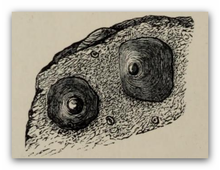Novocrania anomala
| Novocrania anomala | |
|---|---|
 |
|
| Three specimens of Novocrania anomala on a stone | |
| Scientific classification | |
| Kingdom: | Animalia |
| Phylum: | Brachiopoda |
| Class: | Craniforma |
| Order: | Craniida |
| Family: | Craniidae |
| Genus: | Novocrania |
| Species: | N. anomala |
| Binomial name | |
|
Novocrania anomala (Müller, 1776) |
|
| Synonyms | |
|
|
Novocrania anomala is a species of brachiopods found offshore in the eastern Atlantic Ocean.
N. anomala is found from the Canary Isles, Ireland, Scotland, the Faeroe Isles, Norway, Iceland and Svalbard. It is found attached to the bedrock and boulders at a depth of up to 1500 metres in sheltered environments where the water movement is low.
In appearance, N. anomala resembles a cockle or limpet with a low conical, oval shell up to fifteen millimetres long. The upper valve is the only part visible as the lower valve is cemented to the rock beneath. The shell surface is smooth, white, buff or pale grey and has fine concentric lines. The outer surface is covered by a thin brown periostracum.
N. anomala is a filter feeder, using the lophophore between the two valves to selectively catch particles that drift past. It lives for up to ten years but growth is slow after the first year. It is free-spawning with external fertilisation in the water. The eggs sink to the bottom and hatch into free-swimming juveniles. These larvae are fully developed within three days and settle out a few days later, attaching themselves to the substrate. Because N. anomala favours waters with tidal flows of less than one knot, dispersal may be limited.
N. anomala is often the dominant species in its environment. It is eaten by starfish, crustacea, gastropods and fish. Compared to molluscs, the shell is easily drilled into and the shells are often heavily bored. However predation seems to be limited, perhaps because the brachiopod is unpalatable.
...
Wikipedia
